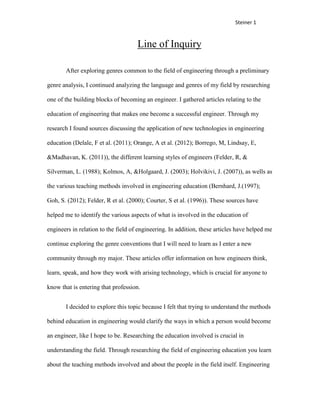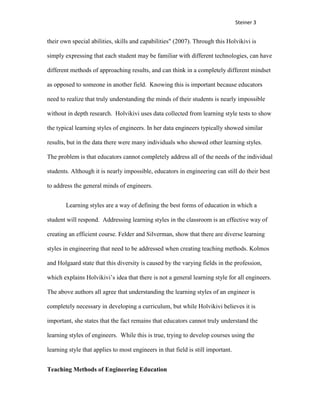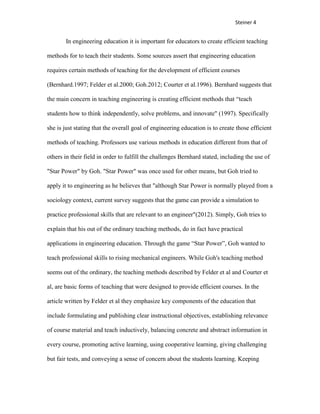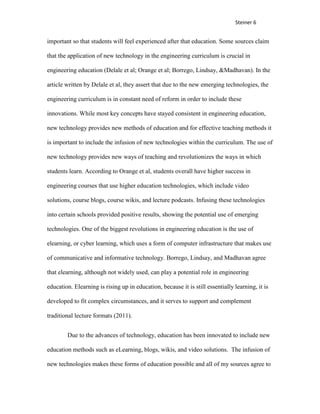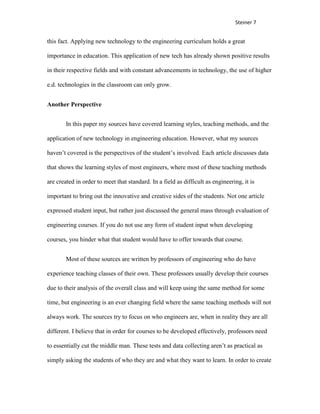Line of inquiry revised
- 1. Steiner 1 Line of Inquiry After exploring genres common to the field of engineering through a preliminary genre analysis, I continued analyzing the language and genres of my field by researching one of the building blocks of becoming an engineer. I gathered articles relating to the education of engineering that makes one become a successful engineer. Through my research I found sources discussing the application of new technologies in engineering education (Delale, F et al. (2011); Orange, A et al. (2012); Borrego, M, Lindsay, E, &Madhavan, K. (2011)), the different learning styles of engineers (Felder, R, & Silverman, L. (1988); Kolmos, A, &Holgaard, J. (2003); Holvikivi, J. (2007)), as wells as the various teaching methods involved in engineering education (Bernhard, J.(1997); Goh, S. (2012); Felder, R et al. (2000); Courter, S et al. (1996)). These sources have helped me to identify the various aspects of what is involved in the education of engineers in relation to the field of engineering. In addition, these articles have helped me continue exploring the genre conventions that I will need to learn as I enter a new community through my major. These articles offer information on how engineers think, learn, speak, and how they work with arising technology, which is crucial for anyone to know that is entering that profession. I decided to explore this topic because I felt that trying to understand the methods behind education in engineering would clarify the ways in which a person would become an engineer, like I hope to be. Researching the education involved is crucial in understanding the field. Through researching the field of engineering education you learn about the teaching methods involved and about the people in the field itself. Engineering
- 2. Steiner 2 education is the foundation of what creates an engineer, and through exploring this topic you learn how that foundation comes into fruition. Learning styles of engineers and effect on engineering education The understanding of learning styles when developing a curriculum has a dramatic effect on education in engineering. Some sources suggest that one's teaching style is a determinant on one's education in engineering (Holvikivi.2007; Felder & Silverman.1988; Kolmos& Halgaard.2003). Felder and Silverman assert that due to the diverse learning styles of engineering students form the need of teaching styles shaped around those learning styles. These teaching styles have a dramatic effect on the quality of ones learning. Although most engineers are active, sensing and visual learners, there are many that have different learning styles. Kolmos and Holgaard suggest that these diverse learning styles are due to the existence of different engineering fields. Because of the variety of fields, there exist all different types of engineers, each type with their own unique learning style. In the class setting the "performance of an individual student in a class depends on a staggering variety of factors", many of which are caused by the individual learning style that one possesses (2003). In order to reduce the negative impact of these factors, Kolmos and Holgaard agree that an educator in engineering must mold their teaching methods into an effective way to address different learning styles present in the students of the course. JaanHolvikivi also address that education requires an in depth analysis on learning styles to improve educational courses in engineering. She acknowledges the fact, however, that "engineering students represent different types of learners; each student has
- 3. Steiner 3 their own special abilities, skills and capabilities" (2007). Through this Holvikivi is simply expressing that each student may be familiar with different technologies, can have different methods of approaching results, and can think in a completely different mindset as opposed to someone in another field. Knowing this is important because educators need to realize that truly understanding the minds of their students is nearly impossible without in depth research. Holvikivi uses data collected from learning style tests to show the typical learning styles of engineers. In her data engineers typically showed similar results, but in the data there were many individuals who showed other learning styles. The problem is that educators cannot completely address all of the needs of the individual students. Although it is nearly impossible, educators in engineering can still do their best to address the general minds of engineers. Learning styles are a way of defining the best forms of education in which a student will respond. Addressing learning styles in the classroom is an effective way of creating an efficient course. Felder and Silverman, show that there are diverse learning styles in engineering that need to be addressed when creating teaching methods. Kolmos and Holgaard state that this diversity is caused by the varying fields in the profession, which explains HolvikiviŌĆÖs idea that there is not a general learning style for all engineers. The above authors all agree that understanding the learning styles of an engineer is completely necessary in developing a curriculum, but while Holvikivi believes it is important, she states that the fact remains that educators cannot truly understand the learning styles of engineers. While this is true, trying to develop courses using the learning style that applies to most engineers in that field is still important. Teaching Methods of Engineering Education
- 4. Steiner 4 In engineering education it is important for educators to create efficient teaching methods for to teach their students. Some sources assert that engineering education requires certain methods of teaching for the development of efficient courses (Bernhard.1997; Felder et al.2000; Goh.2012; Courter et al.1996). Bernhard suggests that the main concern in teaching engineering is creating efficient methods that ŌĆ£teach students how to think independently, solve problems, and innovate" (1997). Specifically she is just stating that the overall goal of engineering education is to create those efficient methods of teaching. Professors use various methods in education different from that of others in their field in order to fulfill the challenges Bernhard stated, including the use of "Star Power" by Goh. "Star Power" was once used for other means, but Goh tried to apply it to engineering as he believes that "although Star Power is normally played from a sociology context, current survey suggests that the game can provide a simulation to practice professional skills that are relevant to an engineer"(2012). Simply, Goh tries to explain that his out of the ordinary teaching methods, do in fact have practical applications in engineering education. Through the game ŌĆ£Star PowerŌĆØ, Goh wanted to teach professional skills to rising mechanical engineers. While Goh's teaching method seems out of the ordinary, the teaching methods described by Felder et al and Courter et al, are basic forms of teaching that were designed to provide efficient courses. In the article written by Felder et al they emphasize key components of the education that include formulating and publishing clear instructional objectives, establishing relevance of course material and teach inductively, balancing concrete and abstract information in every course, promoting active learning, using cooperative learning, giving challenging but fair tests, and conveying a sense of concern about the students learning. Keeping
- 5. Steiner 5 these key components in mind, there is still the issue that the ŌĆ£performance of an individual student in a class depends on a staggering variety of factors, many of which are out of the instructorŌĆÖs controlŌĆØ (2000). Usually this is the case, but through writing this article the authors hoped to describe teaching methods that can benefit the engineering curriculum. The College of Engineering needs to educate students to the point where they are comfortable in that field and develop a teaching method that fits a students learning style. In the article written by Courter et al, they state that the main mission in engineering courses is to "create, integrate, transfer, and apply engineering knowledge"(1996). Simply, this is just acknowledging the some of the main goals involved engineering education. The authors describe that when keeping these goals in mind, one can develop an effective teaching method that addresses each of these goals. Each article addresses the importance of teaching methods and their impact on one's education, and although these teaching methods vary they address the goals of ones education in engineering. All of my sources describe their own teaching method, where Bernhard describes several teaching methods that applies to the different levels of education, while in the articles by Felder et al, Goh, and Courter et al, they describe simply general teaching methods for the overall education. Use of applying new technology in engineering education While creating the curriculum and the teaching methods for engineering education, keeping the infusion of new technology in mind is important. Since technology is a huge part of the engineering career, its application in the education is
- 6. Steiner 6 important so that students will feel experienced after that education. Some sources claim that the application of new technology in the engineering curriculum is crucial in engineering education (Delale et al; Orange et al; Borrego, Lindsay, &Madhavan). In the article written by Delale et al, they assert that due to the new emerging technologies, the engineering curriculum is in constant need of reform in order to include these innovations. While most key concepts have stayed consistent in engineering education, new technology provides new methods of education and for effective teaching methods it is important to include the infusion of new technologies within the curriculum. The use of new technology provides new ways of teaching and revolutionizes the ways in which students learn. According to Orange et al, students overall have higher success in engineering courses that use higher education technologies, which include video solutions, course blogs, course wikis, and lecture podcasts. Infusing these technologies into certain schools provided positive results, showing the potential use of emerging technologies. One of the biggest revolutions in engineering education is the use of elearning, or cyber learning, which uses a form of computer infrastructure that makes use of communicative and informative technology. Borrego, Lindsay, and Madhavan agree that elearning, although not widely used, can play a potential role in engineering education. Elearning is rising up in education, because it is still essentially learning, it is developed to fit complex circumstances, and it serves to support and complement traditional lecture formats (2011). Due to the advances of technology, education has been innovated to include new education methods such as eLearning, blogs, wikis, and video solutions. The infusion of new technologies makes these forms of education possible and all of my sources agree to
- 7. Steiner 7 this fact. Applying new technology to the engineering curriculum holds a great importance in education. This application of new tech has already shown positive results in their respective fields and with constant advancements in technology, the use of higher e.d. technologies in the classroom can only grow. Another Perspective In this paper my sources have covered learning styles, teaching methods, and the application of new technology in engineering education. However, what my sources havenŌĆÖt covered is the perspectives of the studentŌĆÖs involved. Each article discusses data that shows the learning styles of most engineers, where most of these teaching methods are created in order to meet that standard. In a field as difficult as engineering, it is important to bring out the innovative and creative sides of the students. Not one article expressed student input, but rather just discussed the general mass through evaluation of engineering courses. If you do not use any form of student input when developing courses, you hinder what that student would have to offer towards that course. Most of these sources are written by professors of engineering who do have experience teaching classes of their own. These professors usually develop their courses due to their analysis of the overall class and will keep using the same method for some time, but engineering is an ever changing field where the same teaching methods will not always work. The sources try to focus on who engineers are, when in reality they are all different. I believe that in order for courses to be developed effectively, professors need to essentially cut the middle man. These tests and data collecting arenŌĆÖt as practical as simply asking the students of who they are and what they want to learn. In order to create
- 8. Steiner 8 successful courses in the engineering curriculum, I would place an importance on the input of the students to create courses that respond better to that of its students.

